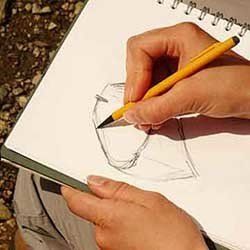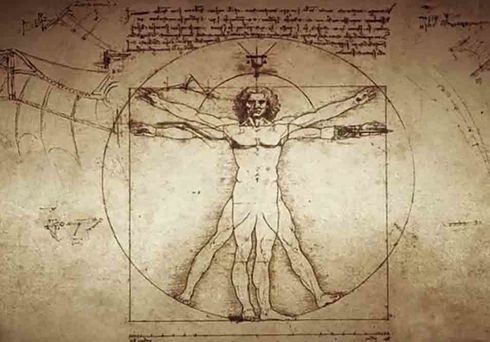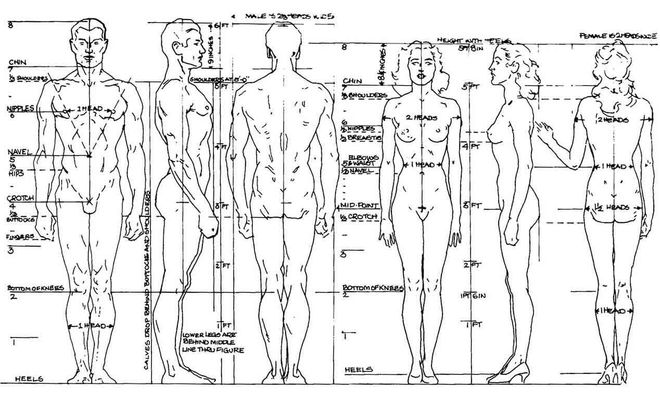Beginners guide: importance of proper body portions and how to get them
Website Editor • February 26, 2020
All bodies are different and no one body is perfect or ideal. Do not confuse proper body proportions with perfect body proportions. Read on to understand why proper body proportions in human figure drawings are important and the best ways to make sure they are always accurate in your own art.
The Importance
Even if you aren’t the greatest artist in the world, if the proportions on your figure drawing are accurate, the realism and integrity of the figure is preserved. We see bodies all the time and the eye knows instinctively when the proportions are out of whack. “Everything that is drawn realistically is drawing with the laws of perspective, even if the artist doesn’t realize that he or she is using them.”
The human body is one of the most complex shapes on the planet. Proportions are the first thing to learn when drawing bodies because they teach you how to be anatomically correct. This can be accomplished by charting out the body and identifying which joints match up to the others.

The Techniques
Artists have been studying the human form for centuries. They have realized that there are a set of guidelines and perspective drawing techniques that vary when you change the subjects’ gender, age or even sometimes ethnic background. Let’s get started with the basics.
- If a figure is proportioned properly, it is defined by something called “the alignment of the joints”, which is the same no matter what. You can start to create this by drawing a head at the top of your paper, and then drawing seven sections of equal height to the head below.
- The bottom of the pelvis rests on the fourth line, the bottom of the knees rest on the bottom of the sixth line and a vertical line can represent each leg, from lines four to eight.
- The area for the ribcage and lungs starts halfway between points 1 and 2. It technically extends down to mark 3, but from around 2.5 to 3 can vary depending on the look of the subjects stomach. Remember that the nipples land on mark 2 and the bellybutton lands around 3.5.
- Shoulders sit around 1.5 and the bottom of the elbow should be level with bellybutton. The hip joints should be level with the wrists. Fingertips should not pass mid-thigh.
It is recommended to practice drawing this form consistently and in different poses and positions.
Remember also that men and women differ slightly in their proportions. As a rule of thumb, mens’ body width should be 2 ⅓ heads, the distance between nipples on the chest is 1 head, the width of the calf muscles at the lower arc is 1 head, and the bottom of the knees is 2 heads from the ground.
Women’s body width is a little smaller: 2 heads wide. Their waists are 1 head wide, buttocks are 1 ½ heads wide, width of the calf muscles at mid point is one head wide and the bottom of the knees should be 2 heads from ground level.
If you practice, over time the proper body proportions will become second nature to you and even if the subject is posed, you will be able to see immediately how long and far apart the limbs should be from the body, etc. and you figure drawing will improve greatly
Articles

The United Nations has described the disruption to education caused by the pandemic as ‘unparalleled’. At the virus’ worldwide peak in April, it is estimated that over 90% of all enrolled learners, from kindergarten to bachelors and beyond, had their education affected by school closures and the pandemic (UNESCO). For many university students and older children, they have had to adapt quickly to online learning. They can keep in touch with their peers and teachers online and continue their studies, albeit in a highly modified way. As challenging as this may be, this experience will help equip them for a future that is increasingly online. For parents of younger children, they are assuming a new role: their child’s home school teacher. This is in addition to their usual childcare and household duties, their work responsibilities and often emotional and financial worries caused by the pandemic. Stressful? Yes. The good, and somewhat surprising, news? The experts advise that you don’t teach your children - at least not in the way you might expect.

If the recent outbreak of Covid-19 has taught us anything, it's that many adults do not wash their hands effectively. It has never been more important that we support our children to develop good personal hygiene to keep themselves and our families safe. This seemingly easy task can be very difficult for children with fine motor skill difficulties. In this article, we explore some ideas to support your child with hand washing.

Lockdown has brought the digital future into the now. Online shopping, entertainment, education and more have moved from the periphery to the mainstream to, in many cases, the only option. With the necessity of social distancing looking to continue for many months, it appears that this rapid digital revolution is here to stay. This means that life as we know it, in most of its sectors, has changed forever. In order to survive, businesses are having to adapt rapidly, embrace technology and look to the future. Architecture is no exception. There has been a widespread adoption of technology and VR over the past few months in response to the lockdown across all of society. Elderly grandparents who were once resistant to adopt new technologies talk of “Zooming” and have started video chatting with their family members to combat loneliness. Art galleries that were once considered stuffy or pretentious are now pioneers in VR technology, with Google Art & Culture offering tours of London’s National Gallery or the Musee D’Orsay in Paris. These virtual tours deliver art in a dynamic new way that can be far more engaging than regular photos. Critics have applauded the panoramic and immersive views of gallery building and exhibitions which work well for rendering of 2 dimensional art, however impressions of sculpture is somewhat lacklustre. With VR technology, users can enjoy a truly immersive experience in the comforts, and safety, of their own home. The COVID-19 pandemic has served as an accelerant for the arts and entertainment industries to embrace VR.





